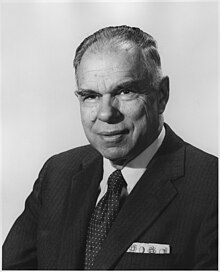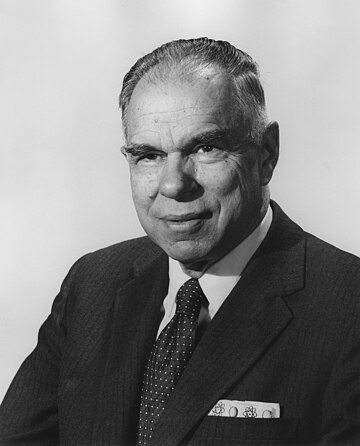യുറേനിയത്തിനുശേഷമുള്ള പത്തോളം മൂലകങ്ങളുടെ കണ്ടുപിടിത്തത്തിനും നിർമ്മാണത്തിലും പങ്കുവഹിച്ച ഒരു അമേരിക്കൻ രസതന്ത്രജ്ഞനാണ് ഗ്ലെൻ ടി. സീബോർഗ് (Glenn Theodore Seaborg) (/ˈsiːbɔːrɡ//ˈsiːbɔːrɡ/; ഏപ്രിൽ 19, 1912 – ഫെബ്രുവരി 25, 1999). ഇത് അദ്ദേഹത്തിന് 1951 -ലെ രസതന്ത്രത്തിനുള്ള നോബൽ സമ്മാനം മറ്റു ചിലരോടൊപ്പം ലഭിക്കുന്നതിന് ഇടയാക്കി.[2] ആവർത്തനപ്പട്ടികയിലെ ആക്ടിനൈഡ് സീരിസുകളെ ശരിയായ രീതിയിൽ അടുക്കുന്നതിനുള്ള ആക്ടിനൈഡ് സിദ്ധാന്തം അദ്ദേഹത്തിന്റെയാണ്.
ഗ്ലെൻ ടി. സീബോർഗ് | |
|---|---|
 Seaborg in 1964 | |
| ജനനം | Glenn Theodore Seaborg ഏപ്രിൽ 19, 1912 Ishpeming, Michigan |
| മരണം | ഫെബ്രുവരി 25, 1999 (പ്രായം 86) Lafayette, California |
| ദേശീയത | United States |
| കലാലയം |
|
| അറിയപ്പെടുന്നത് | his contributions and he was part of a team to the synthesis, discovery and investigation of ten transuranium elements |
| പുരസ്കാരങ്ങൾ |
|
| ശാസ്ത്രീയ ജീവിതം | |
| പ്രവർത്തനതലം | Nuclear chemistry |
| സ്ഥാപനങ്ങൾ |
|
| ഡോക്ടർ ബിരുദ ഉപദേശകൻ |
|
| ഡോക്ടറൽ വിദ്യാർത്ഥികൾ |
|
| ഒപ്പ് | |
Selected bibliography
- Seaborg, G. T.; James, R.A.; Morgan, L.O. (January 1948). The New Element Americium (Atomic Number 95). US Atomic Energy Commission. OSTI 4435330.
- Seaborg, G. T.; James, R.A.; Ghiorso, A. (January 1948). The New Element Curium (Atomic Number 96). US Atomic Energy Commission. OSTI 4421946.
- Seaborg, G. T.; Thompson, S.G.; Ghiorso, A. (April 1950). The New Element Berkelium (Atomic Number 97). UC Berkeley, Radiation Laboratory. OSTI 4421999.
- Seaborg, G. T.; Thompson, S.G.; Street, K. Jr.; Ghiroso, A. (June 1950). The New Element Californium (Atomic Number 98). UC Berkeley, Radiation Laboratory. OSTI 4424011.
- Seaborg, G. T. (December 1951). The Transuranium Elements – Present Status: Nobel Lecture. UC Berkeley, Radiation Laboratory. OSTI 4406579.
- Seaborg, G. T.; Thompson, S.G.; Harvey, B.G.; Choppin, G.R. (July 1954). Chemical Properties of Elements 99 and 100 (Einsteinium and Fermium). UC Berkeley, Radiation Laboratory. OSTI 4405197.
- Seaborg, G. T. (September 1967). The First Weighing of Plutonium. US Atomic Energy Commission. OSTI 814965.
- Seaborg, G. T. (July 1970). Peaceful Uses of Nuclear Energy: A Collection of Speeches. US Atomic Energy Commission. OSTI 4042849.
- Seaborg, G. T., ed. (January 1980). Symposium Commemorating the 25th Anniversary of the Discovery of Mendelevium. Lawrence Berkeley National Laboratory. OSTI 6468225.
- Seaborg, G. T. (August 1990). Transuranium Elements: a Half Century. Lawrence Berkeley National Laboratory. OSTI 6604648.
- Seaborg, G. T. (March 1995). My career as a radioisotope hunter. Vol. 273. pp. 961–964. doi:10.1001/jama.273.12.961. PMID 7884957.
{{cite book}}:|journal=ignored (help)
കുറിപ്പുകൾ
അവലംബം
അധികവായനയ്ക്ക്
പുറത്തേക്കുള്ള കണ്ണികൾ
Wikiwand in your browser!
Seamless Wikipedia browsing. On steroids.
Every time you click a link to Wikipedia, Wiktionary or Wikiquote in your browser's search results, it will show the modern Wikiwand interface.
Wikiwand extension is a five stars, simple, with minimum permission required to keep your browsing private, safe and transparent.
